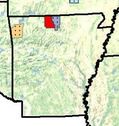 After detecting the fungus that causes white nose syndrome, but not seeing any bats with the disease, for two winters in a row, dead bats showing the symptoms caused by the white nose syndrome fungus were found in an Arkansas cave on January 11, an Arkansas Game and Fish Commission (AGFC) press release says.
After detecting the fungus that causes white nose syndrome, but not seeing any bats with the disease, for two winters in a row, dead bats showing the symptoms caused by the white nose syndrome fungus were found in an Arkansas cave on January 11, an Arkansas Game and Fish Commission (AGFC) press release says.
A total of five dead bats were found during a survey of the Marion County cave. Two of the bats were collected and submitted to the U.S. Geological Survey National Wildlife Health Center where it was confirmed that both bats had the fungus. Both bats had damage to wing, ear and tail membranes consistent with white-nose syndrome, the press release says.
This makes Arkansas the 23rd state to confirm white nose syndrome in bats.
Read the AGFC press release on the US Fish and Wildlife Service’s white nose syndrome web page. (The release was not on the AGFC website when this item was posted.)
Press reports have merely reprinted the press release. See an example here.
See State Wildlife Research News‘ coverage of this past summer’s fungus discovery in Arkansas, here.
Map by Cal Butchkoski, PA Game Commission, used courtesy US Fish and Wildlife Service. This year’s findings are in red.

 The Phoenix Zoo has been trying to get rid of the non-native turtles in the pond in the park near its entrance since 1999. The number of turtle species not native to Arizona found in the pond had declined over the last 13 years, but this year there was an increase. 142 non-native turtles were trapped, including 139 pond sliders, one spiny softshell, one painted turtle, and one eastern redbelly turtle.
The Phoenix Zoo has been trying to get rid of the non-native turtles in the pond in the park near its entrance since 1999. The number of turtle species not native to Arizona found in the pond had declined over the last 13 years, but this year there was an increase. 142 non-native turtles were trapped, including 139 pond sliders, one spiny softshell, one painted turtle, and one eastern redbelly turtle.